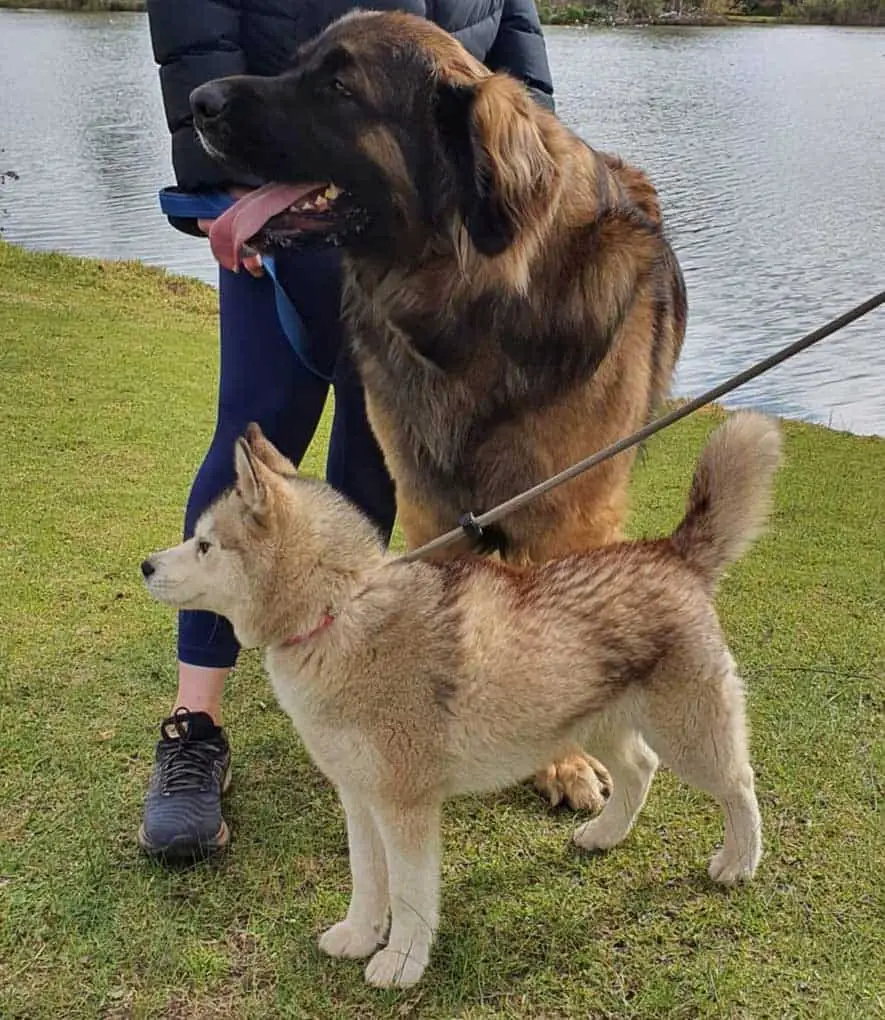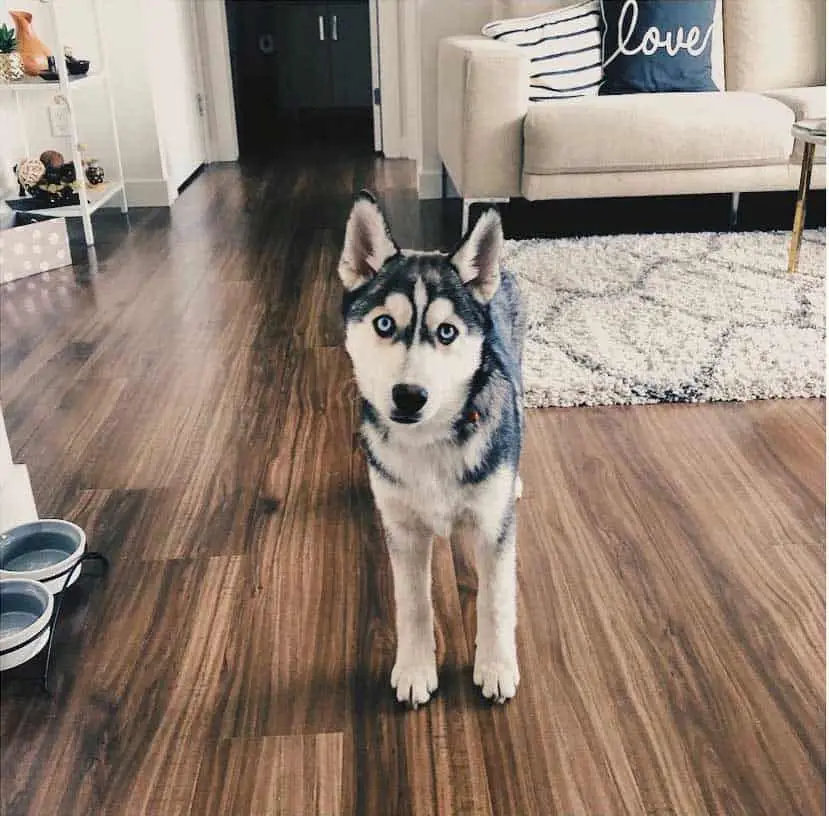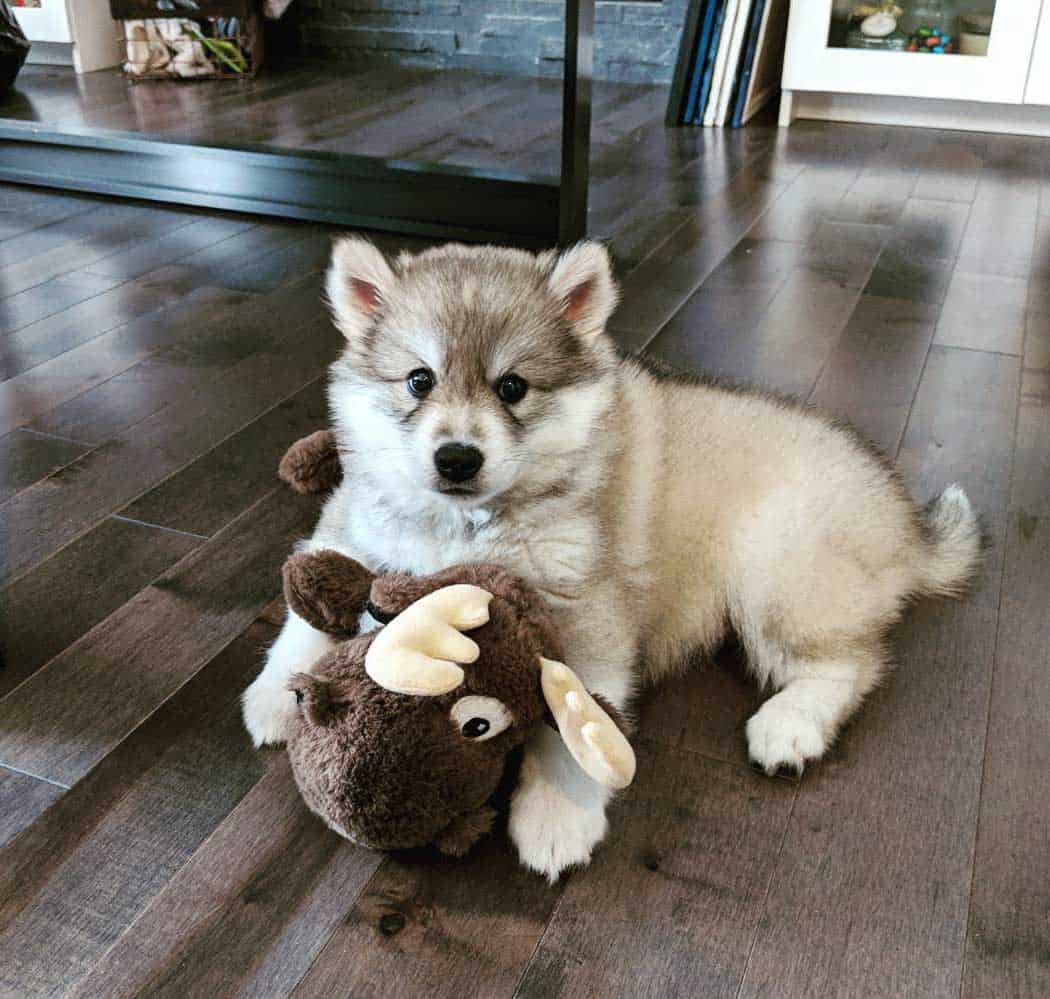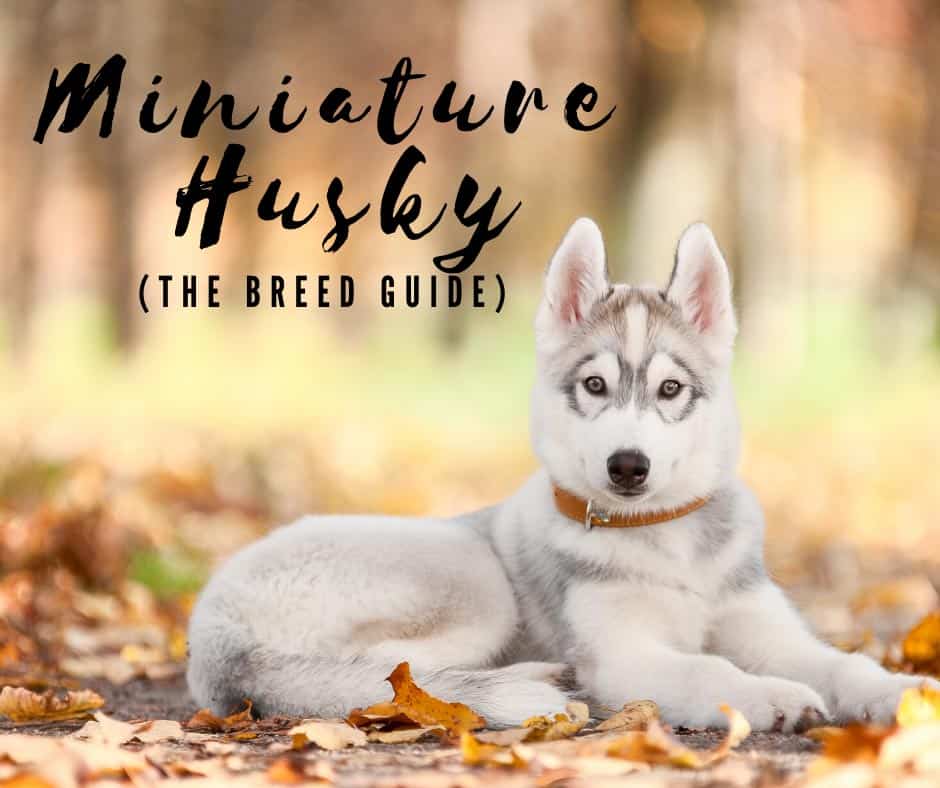
What is a Miniature Husky?
There’s no doubt that humans love having husky as companions. Yet, there also seems to be a trend of making dog breeds even smaller, the pocket-sized version to be more suitable for limited space in housing.
That’s where the idea of the Miniature Husky came from.
The Miniature Husky is a small version of Siberian Husky, created by purposely breeding small-sized dogs from the litter. This breed is known for being friendly, intelligent, and high-energy. Just like a regular Husky, mini Huskies are known for shedding their undercoat twice a year and being prone to eye disorders. They can cost up to $3000.
There are several other breeds, sometimes called a mini husky, teacup husky, miniature husky, or toy husky simply because of the size and appearance, but these dogs have different characteristics and are not to be confused with the original Miniature Siberian Husky. The most popular are:
- Alaskan Klee Kai (distinct breed, recognized by AKC just recently in 2020)
- Pomsky or Pomklee ( crossbreed between Pomeranian and Siberian Husky)
Mini Husky Origin
To understand the history of the Miniature Husky, you first need to learn about the standard Siberian Husky.
The Siberian Husky originated in Siberia (now a part of Russia) several thousand years ago. The breed worked closely with the Chukchi people, excelling as a sled-pulling dog also a family companion. The breed was also known for roaming the area and hunting in packs.
Siberian Huskies were eventually brought over to Alaska in the early 1900s as sled dogs used by locals during the booming gold rush.
There’s no doubt that humans love having husky as companions. Yet, there also seems to be a trend of making dog breeds even smaller, the pocket-sized version to be more suitable for limited space in housing.
That’s where the idea of the Miniature Husky came from.

Miniature Siberian Husky
Back in the 1990s, Bree Normandin set out on a trek to make a miniature version of the highly popular and lovable Siberian Husky. This was made possible by intentionally breeding small-sized Siberian Huskies with one another across several generations. The result was an exact replica of a Siberian Husky, but sometimes only half the size.
The breed has been around for nearly 30 years now.
The American Kennel Club doesn't recognize Mini Siberian Huskies as a distinct breed.
It’s important to note that the only difference between the Miniature Husky and the Siberian Husky is the size. These are the same exact breed in the genetic sense and they share the same colors, behaviors, and other traits as their bigger cousins.
How Does a Mini Husky Look Like?
Siberian Huskies have often been noted for their wolf-like appearance. They are striking, beautiful dogs, with thick fluffy coats and perky, erect ears. Miniature Huskies share the same physical traits, just miniaturized.
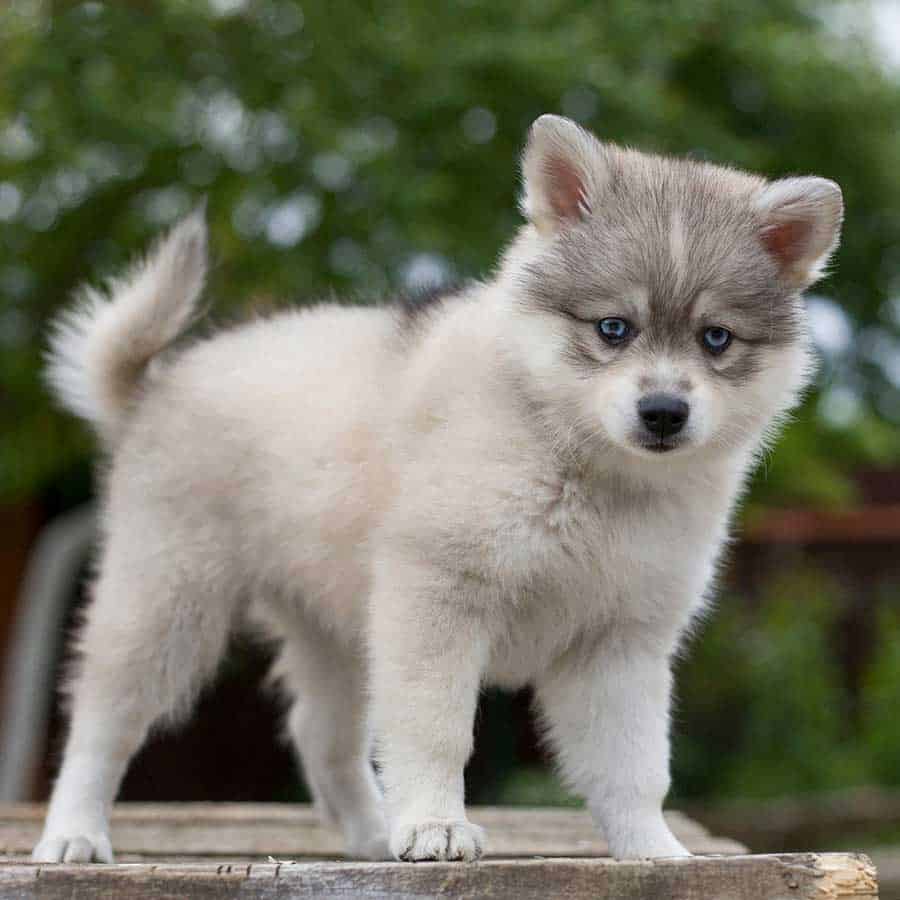
Size and Weight
These dogs grow to 18-25 pounds, compared to a full sized Husky of between 35 and 60 pounds. As mentioned above the miniature husky dog shares similar characteristics to their full sized ancestors, just a smaller version.
Don't think that because they are small they are weaker... definitely not! These little guys are strong and although might not pull a sled on their own, will pull on a leash and require suitable leash training from an early age. Their shorter stature also means they might not walk as far as a Siberian Husky before fatigue sets in, but they still require a lot of daily exercise.
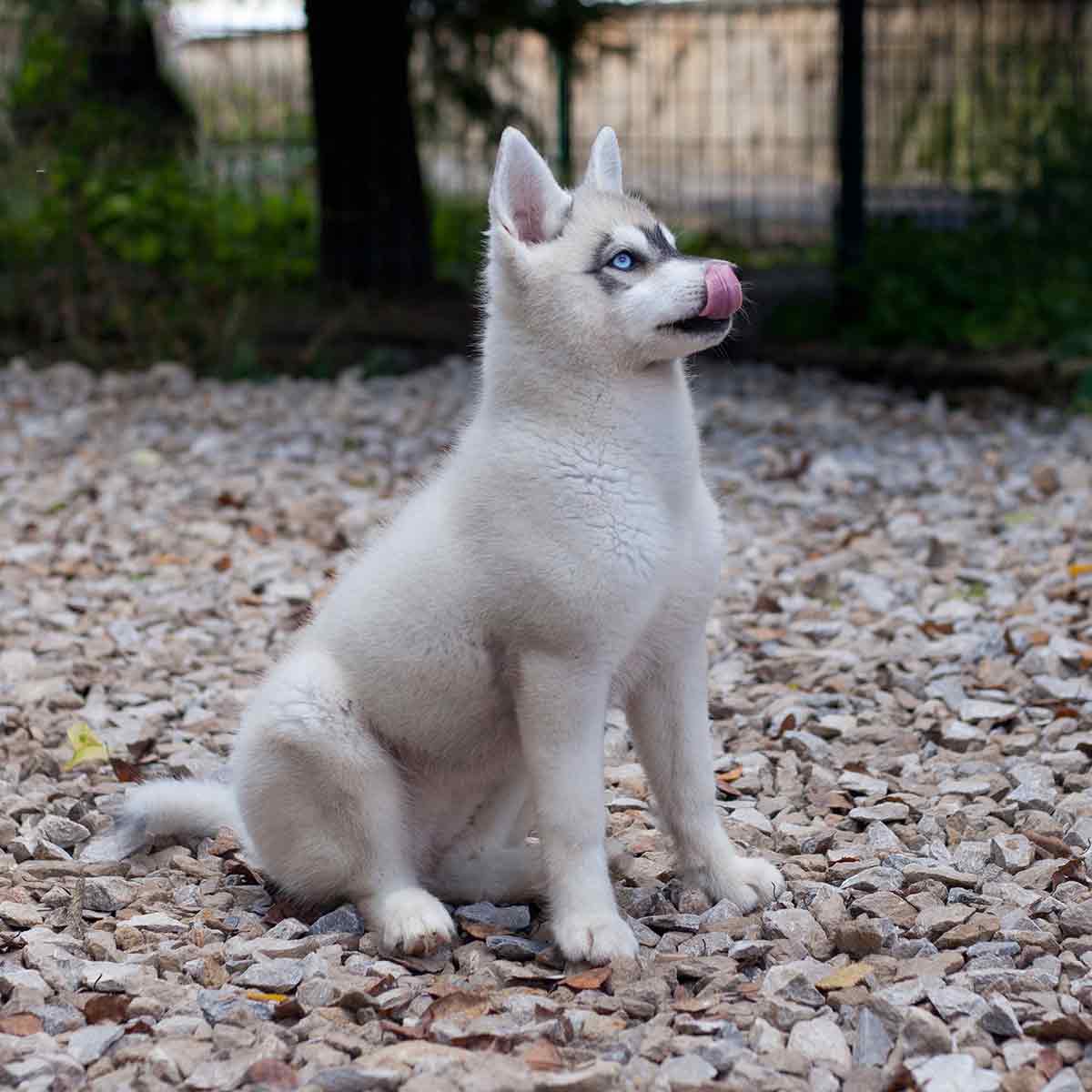
Photo from Kennel "Song of Ice"
Coat
Both Siberian Huskies and Miniature Huskies have a thick double coat. Double coats consist of two layers: an undercoat that traps heat, and a longer topcoat that protects the bottom coat.
During the shedding season, Huskies lose their undercoat. In the summer, their topcoats reflect heat. This helps them to tolerate warmer temperatures.
Miniature Husky coats come in a variety of color variations. Most often, they will be a pattern of white and black, but you will also see rarer coloring include red and white, brown and white, all black, all white and sable huskies.
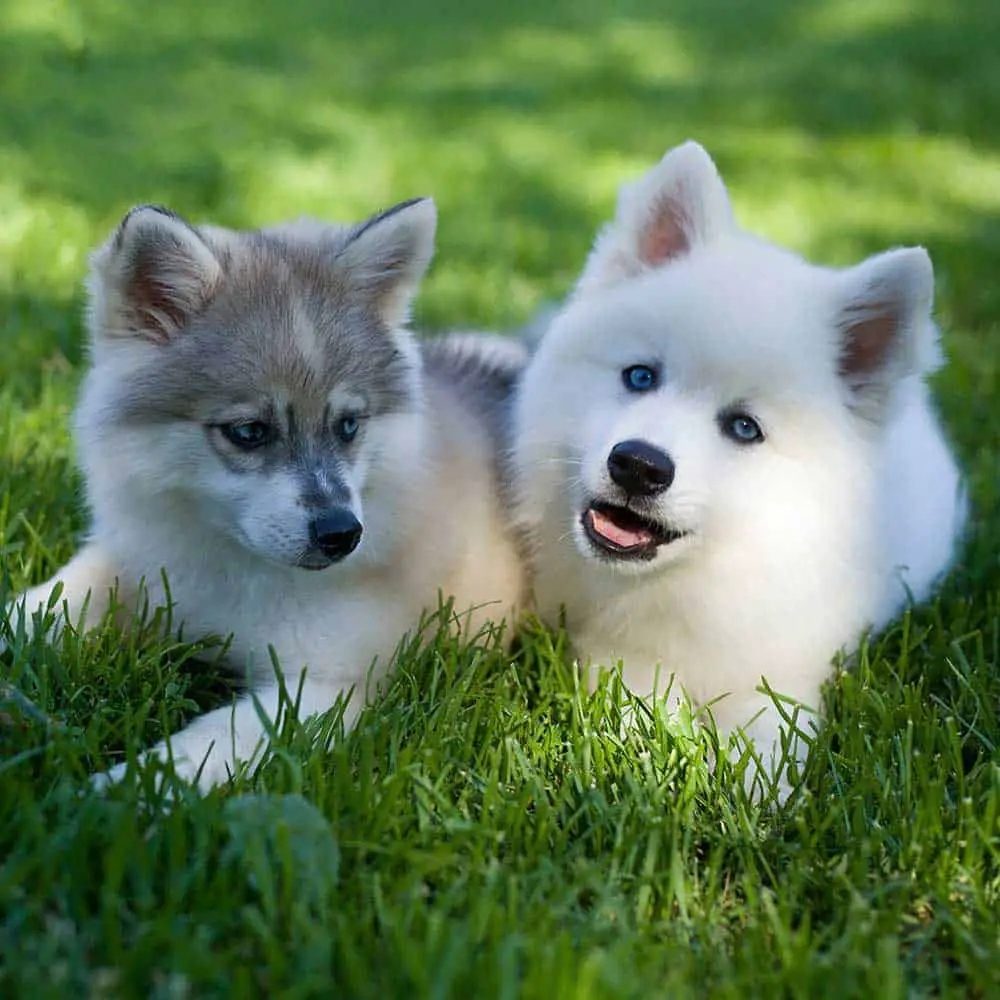
Photo from Kennel "Song of Ice"
Miniature Huskies, like Siberian Huskies, will often have patterns and markings in their fur. Some of them might also adopt a woolier look as a result of thicker and longer hair.
Their coats are extremely thick, and so require grooming and attention. You should brush your miniature Husky’s coat at least once a week. It’s important to note that you should not cut or shave your husky’s hair. Doing so can result in heatstroke during warmer months.
Refer to our Husky Shampoo Guide to keep your husky’s coat shining and soft throughout the year.
Face
Siberian Huskies are notable for their resemblance to wolves. They often have patterned markings on their facial fur. Miniature Huskies have the same appearance, in miniature form.
Eye Color
Siberian Huskies most often have blue or brown eyes. Huskies commonly have heterochromia, a condition that causes the eyes to be of different colors. For example, one eye might be brown while the other is blue. This is also known as being bi-eyed
Sometimes a husky will be parti-eyed. This means that a brown eye might have a speck of blue, or there might be a speck of brown in a blue eye.
Related: Husky Eyes Color: Complete Guide
Ears
Huskies have pointed, erect ears that take on a triangle shape. The ears are often referred to as being “wolf-like.” The husky, like most dogs, is known to have excellent hearing.
Nose
Like most dog noses, husky noses are cool and wet.
Husky noses vary in color. They are usually black, but sometimes brown, red-brown. Some huskies have what is referred to as a “snow nose.” A snow nose will be pinkish colored during colder weather and return to its regular color during the warmer months.
Miniature Husky Temperament
The Miniature Husky is a very unique breed given the history of the Siberian Husky. This breed came from Siberia and spent a significant amount of time outdoors in the snow, pulling sleds and working. Keep in mind that the temperament of the Miniature Husky will vary.
High Energy
The Miniature Husky is perhaps one of the most active dog breeds that you can get. They need constant mental stimulation through playtime and sometimes up to 2 hours of exercise on a daily basis. The Miniature Husky thrives with an active family that enjoys spending time outdoors and running around.
Stubborn
The Miniature Husky is more stubborn than difficult to train. Miniature Huskies are known for being resistant to following the rules and will attempt to rival your dominance in your household. The breed is also known for being a little dramatic, so don’t be surprised if your Miniature Husky throws temper tantrums full of howling and whining. Professional training is a must early on.
Friendly
The Miniature Husky is known for being extremely friendly with other dogs and humans if properly socialized at a young age. It’s not uncommon for a Husky to run up to dogs while at the dog park and begin playing with new friends practically immediately. The breed also craves human attention from family and friends, so this is not a dog that should be left alone at home.
High Prey Drive
The Siberian Husky spent his early days roaming across Siberia, unguided and fending for himself. That’s why the Miniature Husky might not build a strong relationship with cats or small animals in your home that can be seen as prey. A fenced-in yard is absolutely necessary if your Miniature Husky is known to give chase to small animals, like squirrels.
Mischievous
The Miniature Husky is incredibly smart but sometimes is too smart for his own good. Left unattended, it’s not uncommon for Miniature Huskies to get a little rebellious to see what they can get away with. A lack of mental stimulation and physical activity might lead your Miniature Husky to break the rules of the house or venture out of your yard.
Can They Live In Hot Weather?
Given the origins of the Siberian Husky, it should come as no surprise that the Miniature Husky can survive in temperatures well below freezing (sometimes as cold as -60℉). Yet, the double coat of the breed allows your Husky to stay cool during warmer months as well.
However, a Miniature Husky should not be left in very hot temperatures for too long. This can result in severe overheating, dehydration, and even death. Make sure your dog has constant access to water and a shady place to rest when outside in hot temperatures.
Related: How to Care For Huskies in Hot and Tropical Climate?
Are Mini Huskies Good With Other Pets?
The Miniature Husky will do just fine in a home with other dogs, especially other Huskies. These breeds are known for living in packs and enjoy having playmates living in the same home. This can help your Husky to burn more energy during the day through playtime.
Unfortunately, the high prey drive of the breed makes owning cats and smaller animals a difficult task. Don’t be surprised if your Husky attempts to chase and catch your cat, rabbit, ferret, or any other small household animal.
Do Miniature Huskies Make Good Family Dogs?
The friendly and gentle nature of the Miniature Husky makes this the perfect breed for families with children. They are extremely social and thrive on attention, so they will tolerate the curiosity and energy of kids well.
They are also great companions for family outings and will accompany you and your kids on long walks, hikes, or picnics in the park.
If you have young children in your household, be sure to educate them on responsible ways to interact with animals. Even the best-behaved dog can react negatively when prodded or poked the wrong way by a child. Children should never be left alone with dogs and should be taught how to get along with canines.
Housing Requirements
The fact that Miniature Huskies can weigh as little as 15 pounds makes them a great fit for small homes and apartment living. Yet, the small size of this breed doesn’t mean less activity and exercise is necessary.
Your Miniature Husky will need a large yard to run around in for sometimes several hours a day. The yard should be fenced-in to keep your Husky from jumping or climbing over when he sees a squirrel sneaking through the fence. Huskies are also known to dig under fences to escape.
Remember that the Miniature Husky is known for getting a little mischievous if left alone for too long or left to his own devices. This includes being out in the yard or in the house, so be sure to keep your dog entertained as often as possible.
Grooming
With a double coat, Miniature Huskies can leave your home covered with hair throughout the year. That’s especially the case when they’re blowing their coats. This is when your dog’s undercoat will begin shedding in clumps to make room for the growth of healthy hair.
The blowing of the coat usually happens twice a year, most often during weather changes in the spring and in the fall. The whole process will last about two weeks in total, but it can be sped up with frequent grooming.
Brushing
Frequent brushing is absolutely necessary to speed up the blowing process and limit the amount of hair that gets stuck on your furniture. Throughout the year, brushing your Miniature Husky once or twice a week should be more than enough. During the blowing season, you’ll probably want to ramp this up to once a day.
The brush you’re using to groom your Husky will make a huge difference in the impact of shedding. You should be using a brush meant specifically for dogs with undercoats.
The Oster ShedMonster De-Shedding Tool is a great option for your Miniature Husky. This tool will help to gently remove the loose hairs from your dog’s undercoat without yanking or pulling out any healthy hairs. It also has a press release button that removes any hair latched into the brush. Now you don’t have to worry about plucking clumps of hair out of the brush by hand.
Note: Under no circumstances should you shave a Miniature Husky! Many people believe that this is a good idea for reducing shedding and keeping a Husky cool in the summer. This is not true in the slightest and might make your dog more prone to overheating.
Bathing
The Miniature Husky is a great dog to have if you don’t want to spend thousands of dollars at the groomer each and every year. That’s because the Miniature Husky only really needs to be bathed once every few months.
In many cases, your Husky will only need a bath if he gets a little mischievous and rolls around in dirty water or mud while outside.
Bathing your Miniature Husky too often might even be bad for his coat and his skin. The last thing you want is for your dog to have itchy skin. This can lead to excessive scratching and even hair loss in severe cases.
Going to the groomer 3 or 4 times a year might make the grooming process much cleaner and effective for your family.
How Much Should I Exercise a Mini Husky?
There’s no doubt that the Miniature Husky is one of the most active dogs you can add to your family. Your Husky will probably be spending a good hour or two per day running around and playing to burn off whatever energy he has leftover.
But the Husky isn’t a breed that you can just let out into the yard to run around every time. He’s also going to want to spend time with you -- his family -- when he has his playtime. This also serves as the perfect chance to bond with your dog.
Here’s a look at what you might want to do to keep your MIni Husky active and calm:
- Several 30-minute walks per day (2 or more)
- Tug-of-war
- Fetch with a tennis ball, Frisbee, or squeak to
- Chew toys
Just be aware that your Husky’s style of play might not be what you’re used to. Don’t be surprised if he wants you to chase him around the yard in order to get the Frisbee back from him after you toss it.
Sending your Husky out to play on his own too often might result in him chasing squirrels, climbing or jumping the fence, destroying your outdoor furniture, or digging holes.
Diet
What’s great about breeds like Miniature Huskies is that they’re much smaller physically. That means they don’t need to eat as much and will save you a good deal of money over the years.
Exactly how much your Miniature Husky eats will depend on his weight.
The general rule of thumb is that dogs as small as 15 pounds should be eating about 1 cup of kibble per day while dogs as heavy as 30 pounds should be eating closer to 2 cups a day. Yet, the actual amount your dog eats also comes down to how active he is during the day. More active dogs will need more calories to replenish the calories they burn through play.
Puppies should be eating more calories during the day, typically spread out among three meals. Adults should be eating two meals a day instead.
What you feed your Miniature Husky is perhaps even more important. That’s because Husky breeds are known for having delicate stomachs and digestive issues. That means it’s a good idea to invest in kibble made for sensitive stomachs and digestion.
You might also want to add some wet food to your Husky’s diet if he has a low appetite. The smell of meaty wet food might encourage him to eat and maintain a healthy weight.
Supplements
Your dog won’t need supplements to survive, but consistent use of supplements starting in puppyhood can reduce the likelihood of certain conditions and improve the quality of life.
For Miniature Huskies, common conditions include eye problems and joint issues.
That means you might want to give your dog joint supplements in the form of chondroitin and glucosamine. These will help to keep your Husky’s joints lubricated and activity levels in good shape. Supplements that include Omega-3 fatty acids, particularly DHA, will help to improve eye health in cataract-prone Huskies.
Are Miniature Huskies Easy to Train?
It’s not uncommon for Miniature Huskies to resist your dominance and attempt to rule the roost. Letting your Husky get away with even minor rule breaks when he’s young will encourage him to continue this behavior into adulthood.
Not training your Husky in puppyhood will be a nightmare later on.
According to the American Kennel Club, it’s best to start training dogs when they’re as young as 7 to 8 weeks old. This training should be taking place both in the home and with the assistance of a professional dog trainer.
Training includes:
- Teaching basic commands like Sit, Down, Come, and Stay
- Potty training outdoors or on an indoor potty pad
- Leash walking
- Puppy socialization (through classes with a certified trainer)
The problem with training Huskies is that they aren’t always food-motivated. So you might not be able to convince yours to sit or walk nicely on a leash by just putting a meaty treat in front of his face. If that’s the case, you’ll need to see what your Husky does enjoy. You might be able to reward your Miniature Husky with playtime, his favorite toy, or even a few pets instead of food.
All of my previous training tips for Siberian Huskies are suitable for miniature huskies. Of course being a smaller breed of dog you probably won't be exercising as much, or feeding as much, especially when it comes to treats. You will want to use smaller treats and not overdo it.
For more detailed dog training tips including a comprehensive (and affordable!) online course I recommend Doggy Dan's page, as it proves to be very effective online training courses for Siberian Husky.
Leash Walking
Teaching your Miniature Husky to walk on a leash can be the most difficult part of the training. Though your Husky probably won’t be large enough to pull you down the street, there’s a good chance he’ll be attempting to pull you along the entire time.
That comes from the history of the Siberian Husky as a sled-dog.
Yet, your Husky pulling against the leash on a regular collar can put a dangerous amount of pressure on his neck and his throat. That’s especially the case if he pulls for the entire walk or if he suddenly lurches in one direction while chasing a squirrel or chipmunk.
It’s a good idea to get a harness for your Miniature Husky instead.
The Voyager Step-in Air Dog Harness is a solid choice if you’re looking for a soft and gentle harness for a Miniature Husky that loves to pull. This harness will connect to the leash at the back and will limit your Husky’s ability to pull without crushing his windpipe. The soft material is gentle on your Husky’s skin if he does decide to pull.
Life Expectancy
Miniature Husky is known for living between 12 and 15 years. However, helping your dog to stay active and eat a healthy diet can greatly extend the projected lifespan.
Regular visits to the vet, along with regular exercise and grooming, will ensure your pup a long, healthy, and happy life.
Related: How Long Do Huskies Live?
Common Health Problems
Just like every breed out there, the Miniature Husky does have a few conditions that it’s more likely to be diagnosed with. The good news is that Huskies aren’t usually known for being overweight, which means greater overall health.
Eye Issues
The eye problems seen commonly in Husky breeds seem to be hereditary. Though blue eyes are more sensitive to sunlight, there doesn’t seem to be a verified link between eye color and eye disorders in Huskies.
Cataracts might occur in as many as 1 in 10 Huskies. This is a condition where the cornea of the eye begins to take on a cloudy appearance. Small-sized cataracts don’t typically impact vision, but a 100% opacity will result in complete blindness in the affected eye.
Corneal dystrophy is also a common eye condition in Husky breeds. This condition can also result in a cloudy appearance. More commonly, corneal dystrophy will cause slight sensitivity to bright lights or even pain in the eyes. Blindness is possible in severe cases.
Canine Follicular Dysplasia
Canine follicular dysplasia is a condition seen in Miniature Huskies (and plenty of other breeds) that involves hair loss around the trunk area. This most commonly develops when your puppy is between 3 and 4 months old.
Joint Issues
Hip dysplasia typically impacts heavier dogs, specifically because a higher body weight puts extra pressure on the joints in the hips and elbows. Yet, this condition seems to be hereditary in Huskies, regardless of their size.
Hip dysplasia is a condition where the femur (the bone in the upper rear leg) doesn’t fit smoothly into the hip socket. This causes the grinding of the hip joint over a period of time. This condition can be extremely painful and limit your Husky’s ability to run and move as he should.
Miniature Siberian Husky Price
Since Miniature Huskies are bred purely for the allure of having a miniature dog, you’ll almost never find this breed in a shelter. That means you’re going to be spending full-price to buy this puppy from a Miniature Husky breeder.
What you end up paying will depend on how close you live to a breeder.
In most cases, you can expect to pay $2000 to bring Miniature Siberian Husky puppy home. Mini Huskies that come from a good line or have unique markings might cost you upwards of $2,500. You also have to factor in travel costs, which can bring your expenses well over $3000.
You can drive across the country to pick it up yourself, if you have the time and gas money. Alternatively (and perhaps more practical) you can have the puppy air-freighted to you via commercial passenger airlines. This will attract handling fees between $100-150, plus the cost of the flight ($200-400).
Whichever way you look at it the Miniature Siberian Husky is not a cheap puppy. Prices are likely to remain high for many years to come until breeding stock increases.
The Yearly Cost of Owning a Mini Husky
Bringing home a Miniature Husky puppy is definitely pricey, but you also need to factor in the cost of care for this dog from puppyhood to adulthood.
For food, you should expect to feed your Husky no more than 2 cups of dry food per day. Since there are about 4 cups of kibble in every pound of dry food, a 30-pound bag of Purina Pro Plan Sensitive Skin and Sensitive Stomach Dry Dog Food might last you a good two months. So expect to spend around $25 a month on dry food.
Then there are the much-needed supplements to keep your Miniature Husky healthy well into adulthood. Supplements like the Pet Naturals - Daily Multi for Dogs will provides essential fatty acids and antioxidants that can be degraded in the production of common pet foods. With 150 soft chews per jar, this should cost you about $9 a month.

Make sure you think about the cost of getting your Miniature Husky the necessary round of puppy shots during his first year as well as a yearly checkup, totaling about $200 between the two visits.
Grooming can be another $50 or so for each visit, so going to the groomer three times a year will tack on an extra $150 to ownership.
Costs to Own a Mini Husky puppy during the first year?
What You Need | Cost |
|---|---|
Food | $300 |
Supplements | $100 |
Puppy Shots | $100 |
Vet Visit | $100 |
Grooming | $150 |
TOTAL | $750 |
You’re looking at about $750 during the first year and potentially $650 a year to care for your Miniature Husky after that. This doesn’t include the cost of grooming products, toys, beds, and emergency vet visits. Be sure you have enough money to cover the additional costs that come with pet ownership.
Where Can I Buy Mini Huskies?
There is a long wait list for Miniature Siberians. Two months if you are lucky, more like four to six or longer. You may be required to pay a non-refundable deposit just to get on that waiting list!
The breed is so exclusive that if you are in the USA or Canada you are pretty much only able to deal with one or two parties. If you are outside of these areas, your only hope is to export the puppy yourself out of the country, which is a time consuming, expensive, and potentially frustrating exercise.
There are very few Miniature Siberian Husky Breeders around, that we know so far:
In the USA: Check this private breeders:
- Burch Kennel Club Mini Huskies (Indiana)
- Mini Husky Country in Oregon (Oregon)
- Isac Ramirez and Ashley Robinson (breeders from North Carolina, who as stated on their website, continues Bree Normandin's development and work diligently as hobby breeders to produce quality Miniature Siberian Husky)
In Canada: Try contacting Canadian Pomsky who are reportedly offer Miniature Siberian Huskies in addition to their regular Pomski puppies to Canadians.
A WARNING! Puppies For Sale
There are some reports floating around on the Internet (such as here or this Facebook group) , suggesting that that deposits are being taken without any delivery, and that the lineage of the miniature huskies may not be pure. We can not confirm nor discredit these claims. Please do your homework, establish communication channels, and get a realistic idea of delivery before placing a deposit down at any breeder, not just this one. Remember that supply is extremely limited and long waiting lists can apply. Responsible breeding takes time to build up enough puppies to meet demand.
Can I Rescue a Miniature Siberian Husky?
Forget it! The tiny numbers of Miniature Siberian Husky puppies, and their exclusive nature, means you just won't see them turning up in pounds and shelters. However this should not deter you from adopting a standard Siberian Husky from a rescue shelter. If you want to help save an animal, you really should check our list of Siberian Husky Rescue Organizations and Agencies , that you can make contact with and find out more about what they do and how you can help.
Is There Any Alternatives to Mini Husky?
There are two closely-related breeds to Huskies that are keeping the adult dog size small whilst still keeping most of the same appearance and temperament of a Husky. These are the Miniature Siberian Husky, and the Alaskan Klee Kai.
Often mistakenly referred to as Mini Huskies, the Alaskan Klee Kai is a breed in its own right. It is different from the Miniature Siberian Husky and more closely related to the Alaskan Husky. However there are similarities and the good news is that Klee Kai's have more breeders and better puppy availability, including outside the USA. More information can be found in our article on the Alaskan Klee Kai.
Miniature Husky FAQs
Are Miniature Huskies Hypoallergenic?
No, Miniature Huskies are not hypoallergenic. They shed a lot during their shedding season, and will also shed a bit throughout the entire year.
Dog allergies come from dog hair. Dog saliva and allergy-inducing dander get stuck to the dog hair, which then gets spread throughout the home. Huskies have thick, layered coats and their hair can spread easily throughout your home.
If you have a family member with bad pet allergies, consider purchasing a non-shedding dog. Non-shedding dogs like poodles will spread less saliva and dander filled hair throughout the home.
Can I Kennel My Miniature Husky?
Miniature Huskies are extremely active, energetic dogs. They do not take well to being kennelled for most of the day. They depend on love, affection, and attention.
If you work long hours and are looking for a dog breed that can handle being kenneled for hours at a time, consider a labrador or other breed that needs less exercise.
It’s important to note that all dogs need exercise and affection, and should not be kenneled all day without relief.
Conclusion
The Miniature Husky has become an extremely popular dog breed in the last several years. Here’s what you need to know about the breed before bringing one home:
- They’re known for being very active and friendly.
- They need a fenced-in yard and a few hours of playtime a day.
- They get along well with dogs and children, but not with smaller animals.
- They blow their coat twice a year and only need baths when they get dirty.
- They need to eat between 1 and 2 cups of food a day.
We hope all you Siberian husky lovers learned a lot! We want to hear about your quest to finding the perfect mini siberian husky! Let us know below in the comments how you managed to find a breeder!
